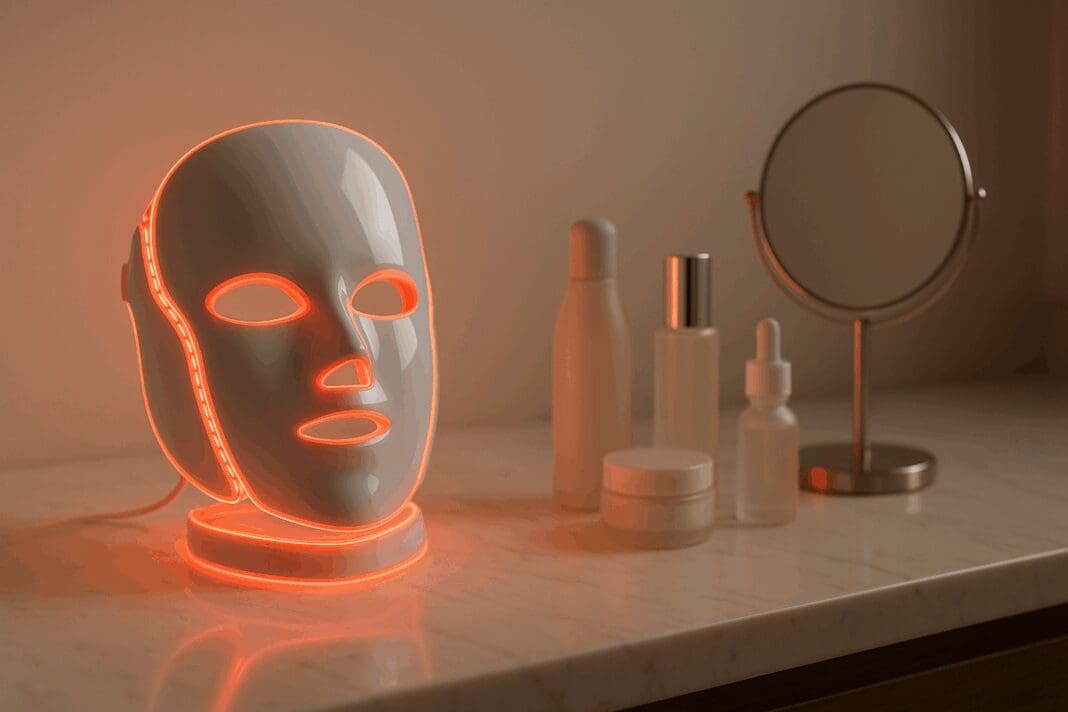In the ever-evolving realm of beauty technology, few innovations have captured the attention of dermatologists, aestheticians, and skincare enthusiasts quite like light therapy. Whether you’re navigating professional treatments or exploring at-home gadgets, understanding how to use face light therapy effectively can mean the difference between short-term novelty and long-term transformation. Light therapy—once reserved for medical clinics—has now made its way into the hands of consumers, offering targeted support for acne, aging, pigmentation, and inflammation. But to truly unlock the potential of these devices, one must go beyond casual usage and embrace the deeper science, application strategies, and practical routines that inform expert-level results.
You may also like: The Vital Truth About When to Start Hormone Replacement Therapy During Menopause
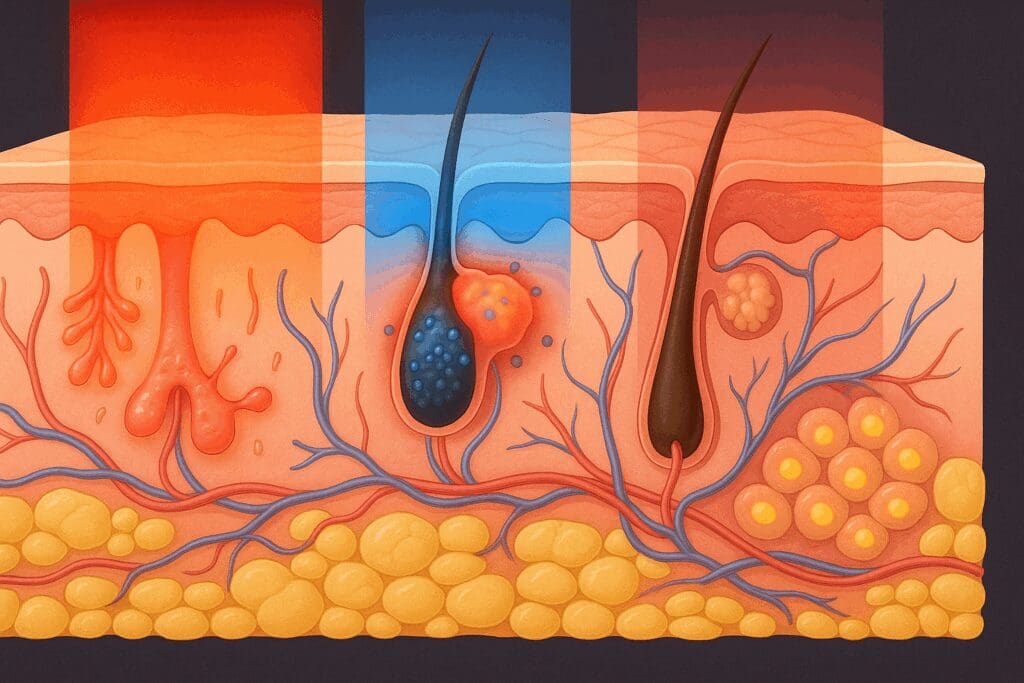
Understanding the Science Behind LED Therapy Facial Technology
At its core, LED therapy facial technology harnesses specific wavelengths of light to penetrate the skin at varying depths, stimulating cellular activity without causing heat damage or discomfort. The primary forms of light used in these treatments—red, blue, and near-infrared—each possess distinct biological effects. Red light, with its longer wavelengths, penetrates deeply into the dermis and is widely recognized for its ability to boost collagen production, reduce inflammation, and accelerate healing. Blue light, on the other hand, is more surface-focused and has antimicrobial properties that target acne-causing bacteria such as Propionibacterium acnes. Near-infrared light goes even deeper, promoting circulation and aiding in cellular repair at the mitochondrial level.
These non-invasive treatments tap into photobiomodulation, a process through which light energy is absorbed by the skin’s chromophores and converted into chemical energy that supports tissue repair and anti-aging. It is crucial to note that the benefits of these treatments depend heavily on proper wavelength calibration and energy density (measured in joules/cm²), both of which influence efficacy. Many skeptics continue to ask, “Do LED light masks work?” or “Does LED light therapy work on face issues like fine lines or acne?” The clinical answer—when devices are properly used and meet regulatory standards—is a resounding yes. However, this is contingent upon consistency, the right wavelength, and adherence to optimal usage protocols.
Debunking the Skepticism: Do LED Masks Actually Work?
One of the most frequently asked questions in the beauty tech space is, “Do LED masks actually work?” The proliferation of affordable at-home devices has sparked equal parts enthusiasm and skepticism. While some users report minimal results, others showcase dramatic transformations in skin texture, tone, and radiance. The variation often lies not in the technology itself, but in its implementation. Scientific studies and dermatologist-backed reviews consistently affirm the effectiveness of LED therapy when it is used correctly and consistently over time.
Clinical trials support these findings. A 2014 study published in the Journal of Clinical and Aesthetic Dermatology demonstrated significant improvements in skin complexion, collagen density, and wrinkle depth after 12 weeks of red light therapy. Similarly, blue light has been shown to reduce acne lesions by more than 50% in some individuals when applied daily. So, when consumers question, “Do light masks work?” the answer is yes—under the right conditions. Devices that utilize medical-grade LED bulbs, operate at clinically supported wavelengths (typically between 415nm for blue light and 633nm for red light), and offer sufficient energy output are capable of delivering transformative results.
The trouble arises when consumers purchase subpar gadgets or fail to follow consistent treatment regimens. Many budget-friendly products lack sufficient power or appropriate light settings, leading to disappointment and skepticism. However, those using reputable brands or professional-grade equipment generally find the benefits in line with clinical expectations, particularly when combined with a personalized skincare regimen.
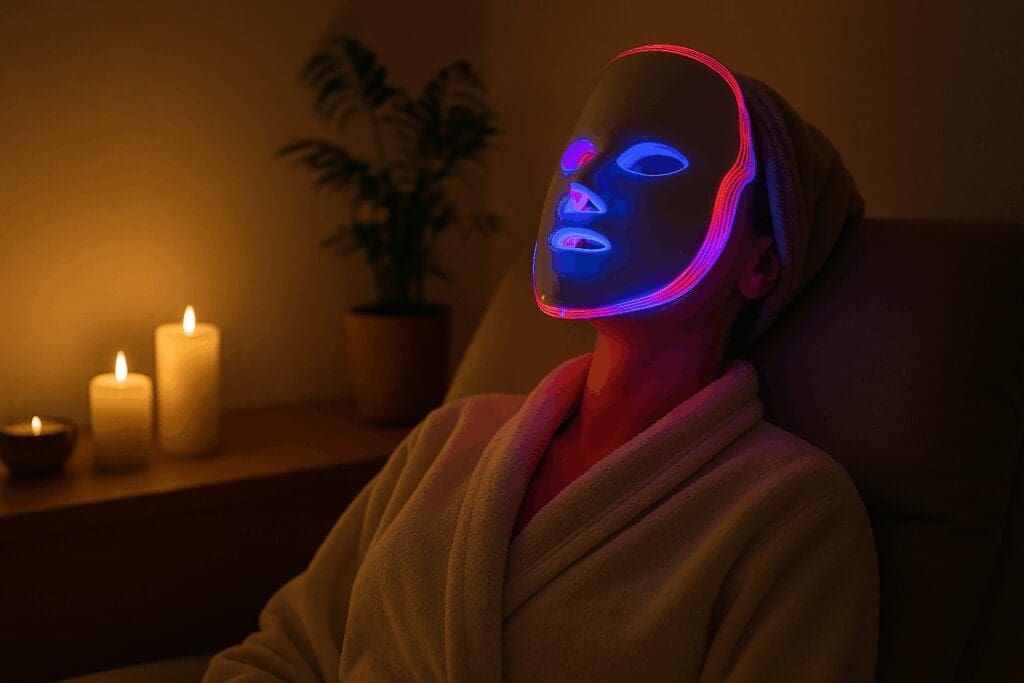
How to Use Face Light Therapy for Acne, Aging, and More
Learning how to use face light therapy properly begins with a clear understanding of your skin’s specific needs and the type of device you’re using. Devices range from full-face masks and handheld wands to LED panels and flexible wraps. Red light is ideal for mature skin or anyone seeking anti-aging benefits. When used consistently—typically 10 to 20 minutes per session, three to five times per week—red light can stimulate fibroblasts to increase collagen and elastin production, reduce wrinkles, and improve skin tone.
For acne-prone individuals, blue light offers a powerful tool for bacterial control. Applied daily or every other day, blue light therapy can significantly reduce active breakouts and prevent future ones by deactivating P. acnes bacteria without harsh chemicals or antibiotics. Some devices combine red and blue light in alternating modes or simultaneous pulses, which helps address both inflammation and infection—making them suitable for combination therapy.
Consistency and technique are paramount. Always cleanse the skin thoroughly before application, ensuring no skincare products interfere with light absorption. Depending on the device, the treatment duration and frequency may vary, but most protocols recommend a minimum of eight to twelve weeks for visible improvement. Some users may also opt for near-infrared light, which penetrates deeper and supports wound healing, making it ideal for post-procedural care or chronic inflammatory conditions such as rosacea.
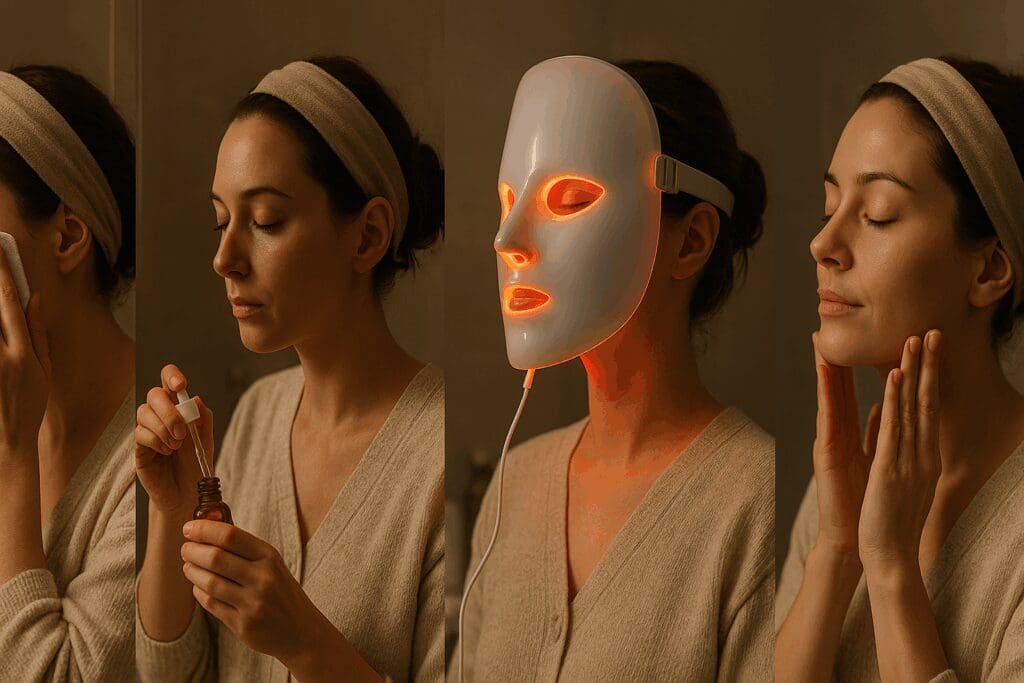
Setting Up Your Routine: A Step-by-Step Guide for Optimal Results
Establishing a structured and effective LED routine starts with selecting a high-quality device. Look for certifications such as FDA clearance or CE marking, which indicate adherence to safety and performance standards. Once you have a reliable product in hand, the first step is always cleansing the skin. This removes any barriers—like oils, makeup, or sunscreen—that could block the light from penetrating.
After cleansing, some users apply serums containing ingredients like hyaluronic acid or peptides. These are generally safe under LED light and may even enhance results by hydrating the skin and supporting the regenerative process. Avoid retinol, AHAs, or vitamin C immediately before treatment, as these can increase photosensitivity or interfere with the therapy.
Position your device according to manufacturer instructions. If you’re using a mask, ensure it sits flush against your skin without gaps. For wands or handheld tools, slowly glide them over the treatment area in small, overlapping circles or in a grid-like pattern. For LED panels, maintain the recommended distance—typically six to twelve inches—and wear the device for the full duration of the session.
Post-treatment, follow up with a nourishing moisturizer or post-light serum that reinforces the benefits of the session. Always use sunscreen during the day, as light therapy may make your skin more sensitive to UV exposure. Tracking your sessions in a journal or skincare app can help you remain consistent and notice trends over time. This structured routine is key to answering questions like “Do LED light masks work?” because user behavior—more than product design—is often the deciding factor in visible improvement.
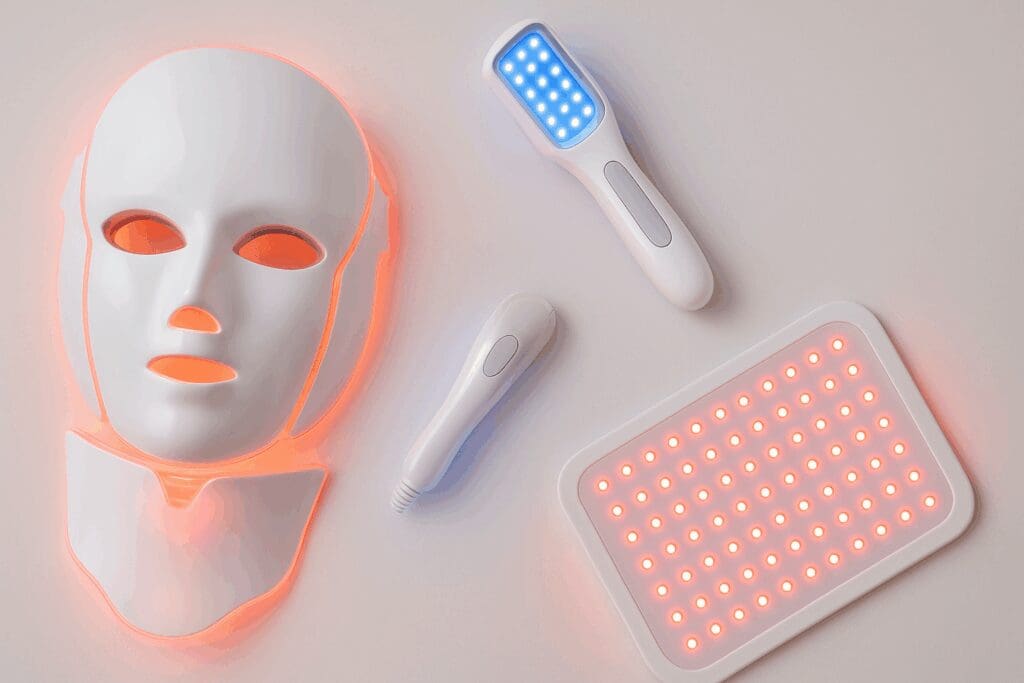
Device Selection: What to Look for in Quality Face Light Therapy Gadgets
Choosing the right LED therapy device is a pivotal step in maximizing your skin rejuvenation efforts. While it may be tempting to opt for inexpensive options, not all LED masks are created equal. Device efficacy is largely determined by its light intensity, wavelength accuracy, and uniformity of light distribution. Red light should fall between 620–660nm to stimulate fibroblast activity effectively, while blue light should stay in the 405–470nm range to exert antibacterial effects. Higher-end devices also include near-infrared wavelengths (around 850nm), which penetrate deeper layers of the skin and support vascular health and tissue regeneration.
Equally important is energy output. Many clinical studies use a dose of 4 to 6 joules/cm² delivered over a treatment period of 10 to 20 minutes. Devices with low output will not reach this threshold and may require excessive treatment durations to be effective. This is often a key factor behind consumer complaints like “Do LED masks actually work?”—not because the technology is flawed, but because the tool lacks sufficient strength.
Features like adjustable wavelength modes, built-in timers, and ergonomic design also influence usability and results. Additionally, make sure your device offers eye protection or comes with goggles, especially when using higher-intensity blue light. Finally, consider customer service, warranty, and third-party certifications when evaluating brands. A trustworthy company not only ensures safe operation but often provides helpful resources on how to use face light therapy with your specific skin type and concerns.
The Role of Professional Treatments in Amplifying Results
While at-home devices have become increasingly sophisticated, professional treatments still offer a level of intensity and customization that cannot always be matched. In-clinic LED therapy sessions often use higher-powered devices that deliver light at optimal doses and include combinations of red, blue, amber, and infrared wavelengths. These treatments may also be combined with microdermabrasion, microneedling, or chemical peels for enhanced penetration and accelerated results.
Clinics often tailor sessions to address acute issues such as cystic acne, post-inflammatory hyperpigmentation, or aging-related laxity. Trained professionals can monitor your skin’s response and adjust treatment parameters accordingly. For individuals struggling with chronic conditions or stubborn concerns, in-office treatments offer a reassuring answer to “Does LED light therapy work on face conditions that haven’t responded to traditional skincare?”
Moreover, professional oversight ensures consistent application and minimizes user error—two variables that frequently contribute to underwhelming outcomes with at-home devices. However, the two are not mutually exclusive. Many patients alternate between clinic visits and home-based maintenance routines, reinforcing the therapy’s effects while preserving the benefits between appointments.
How to Use Face Light Therapy in Conjunction with Other Skincare Regimens
One of the most strategic ways to enhance your LED therapy facial results is to integrate it into a broader skincare routine designed to support and magnify its effects. Light therapy is not a standalone solution; rather, it acts as a force multiplier when used alongside evidence-based skincare ingredients. Red light, for instance, is synergistic with peptides, niacinamide, and hyaluronic acid—all of which support collagen production and cellular hydration. These ingredients create an environment in which red light can work more effectively to rejuvenate aging or tired skin.
For acne-prone users, combining blue light therapy with salicylic acid or benzoyl peroxide—used at different times of the day—can provide a dual-action effect. While the chemical agents exfoliate and unclog pores, blue light neutralizes the bacteria that trigger breakouts. This multi-pronged approach significantly improves success rates and answers skeptical questions such as “Do LED light masks work on hormonal or cystic acne?”
It’s essential, however, to avoid using photosensitizing agents such as retinoids or strong AHAs directly before light exposure. These can make the skin more vulnerable and reactive. Instead, reserve these treatments for the evening or alternate days. Light therapy is also well-suited for use after minimally invasive procedures, where its anti-inflammatory and healing-promoting properties can reduce downtime and speed recovery.
Creating a Personalized Protocol: Tailoring Light Therapy to Your Skin’s Unique Needs
Understanding how to use face light therapy is not just about following generalized instructions—it’s about tailoring the experience to your unique skin biology and lifestyle. Skin is a dynamic organ, influenced by internal factors like hormones and nutrition and external elements such as weather, pollution, and stress. This means that even the most advanced light therapy gadgets must be employed with a customized approach to deliver optimal outcomes.
For individuals dealing with acne-prone skin, daily or every-other-day sessions with blue light may be most effective during flare-ups, gradually tapering to maintenance treatments twice a week. If your primary concern is fine lines, loss of elasticity, or age spots, red or near-infrared light sessions three to five times per week can support sustained collagen synthesis and improve dermal thickness over time. Those managing rosacea or other inflammatory skin conditions may benefit from alternating between red and amber lights on a more cautious schedule, observing how their skin reacts and adjusting accordingly.
Seasonal adjustments are also worth considering. In the drier winter months, the skin may become more sensitive or prone to dehydration. During this time, coupling LED therapy with hydrating masks or ceramide-rich moisturizers can buffer against sensitivity. In the summer, however, post-sun exposure use of red light therapy can help soothe and restore compromised skin while minimizing photodamage.
Tracking your skin’s response over time is key. Journaling weekly progress, taking periodic photos under consistent lighting, and noting any irritation or breakthrough improvements can help you refine your routine. A flexible, responsive approach ensures that your regimen evolves alongside your skin, making each session more strategic and impactful.

The Neuroscience of Light: How LED Therapy May Influence More Than Skin
Although most discussions focus on surface-level aesthetics, the effects of light therapy may reach beyond the dermis into the neurological realm. Emerging research has begun exploring the potential cognitive and psychological benefits of near-infrared and red light when applied to specific zones on the face and scalp. These wavelengths have been shown to enhance mitochondrial ATP production and cerebral blood flow, which may support cellular repair and even modulate neurotransmitter activity.
This opens up a fascinating new frontier in understanding whether LED therapy facial treatments can influence mental clarity, mood stabilization, and circadian rhythm regulation. For instance, applying near-infrared light around the temples and forehead—areas rich in cranial vasculature—has been preliminarily linked with reduced symptoms of depression and anxiety in some pilot studies. While these claims are still being validated, they raise exciting questions for those interested in whole-body rejuvenation.
Furthermore, consistent use of face light therapy in the evening may promote better sleep by encouraging melatonin production, particularly if used as part of a calming, screen-free nighttime routine. Just as morning exposure to natural light cues the body to wake up, evening exposure to red light may mimic sunset wavelengths and help the brain wind down. This alignment with circadian principles may be particularly helpful for individuals with sleep disorders or high stress levels.
Thus, when asking “Does LED light therapy work on face issues?”, we might soon expand that query to consider the broader biopsychosocial effects of targeted light exposure. The interplay between skin, brain, and light remains a thrilling, if underexplored, dimension of LED technology.
From Trend to Treatment: Why LED Therapy Is Becoming a Dermatological Mainstay
It’s worth noting that LED therapy facial devices are no longer the novelty they once were. Dermatologists increasingly recommend them not only for cosmetic purposes but also as adjunctive tools in treating chronic skin conditions. Photodynamic therapy, a clinical version of blue light therapy paired with photosensitizing agents, has been used for years to treat pre-cancerous lesions, demonstrating the serious medical potential of controlled light exposure.
More recent applications have emerged in managing conditions like psoriasis, eczema, and vitiligo, where inflammation and cellular dysfunction play a central role. Red and near-infrared light have anti-inflammatory and immunomodulatory effects that make them useful in these contexts, helping to reduce itchiness, redness, and flares without the systemic side effects of corticosteroids.
In cosmetic dermatology, LED light is often used as a “finishing touch” after procedures such as microneedling, laser resurfacing, and injectables. These treatments, while effective, can leave the skin temporarily inflamed or vulnerable. LED therapy accelerates healing, reduces bruising, and enhances overall results. It’s also completely painless and requires no downtime, making it appealing for patients who prefer non-invasive options.
This growing clinical endorsement further supports the answer to the recurring question: “Do LED masks actually work?” In fact, their efficacy is now considered a foregone conclusion by many professionals. The more pertinent discussion has shifted to questions of personalization, frequency, and integration with other treatments. As such, the credibility of LED therapy continues to solidify, not just as a trend, but as a legitimate pillar of modern skin health.
Addressing the Persistent Question: Do Light Masks Work for Everyone?
Despite the growing popularity of face light therapy, not every user will experience the same level of success. A variety of individual factors—skin thickness, pigmentation, underlying medical conditions, age, and even genetics—can influence responsiveness to treatment. Moreover, expectations must be realistic. LED therapy is a cumulative treatment that works slowly over time; it is not designed to produce instant results after a single session.
For people with deeper wrinkles or severe acne scarring, LED therapy may produce moderate improvement but should not be viewed as a replacement for more intensive interventions like CO2 lasers or subcision. It’s also less effective on hyperpigmentation caused by melasma, which typically requires more targeted, pigment-specific treatments. However, for mild to moderate concerns such as fine lines, mild acne, or dull skin tone, light therapy remains a highly effective, low-risk option.
This variability underscores why some users question, “Do light masks work?” when they don’t see dramatic results. It’s essential to recognize that skincare is not a one-size-fits-all journey. The key to success lies in informed usage, appropriate expectations, and complementary care. When approached from this perspective, face light therapy becomes a valuable component of a holistic skincare strategy.
How to Use Face Light Therapy to Maximize Long-Term Benefits
To truly harness the rejuvenating power of LED, one must embrace it as a long-term investment in skin health, not a quick fix. The initial weeks of treatment lay the foundation for cellular change, but the most significant improvements often occur after two to three months of consistent use. During this time, dermal fibroblasts become more active, collagen synthesis is sustained, and skin texture visibly improves.
To maximize these effects, avoid abrupt discontinuation. Instead, once your goals are achieved, taper to a maintenance phase—perhaps two to three sessions per week. This rhythm supports continued skin renewal and prevents regression. Reinforce this with topical ingredients like vitamin C (in the morning) and peptides (in the evening), which help lock in the progress stimulated by light exposure.
Don’t neglect lifestyle habits that either support or sabotage your results. Smoking, excessive sun exposure, poor sleep, and a processed diet can all counteract the benefits of LED therapy. Conversely, staying hydrated, managing stress, and eating antioxidant-rich foods can help your skin respond more robustly to treatment. These holistic practices add momentum to the changes initiated by light, turning temporary improvement into enduring transformation.
Asking “How to use face light therapy?” should not be limited to surface technique. It should extend into daily rhythms, wellness choices, and the overarching narrative you are crafting for your skin. The best results arise not from occasional enthusiasm but from a sustained, mindful partnership with your body’s regenerative capacity.

Integrating Beauty Tech into a Smart Skincare Ecosystem
The rise of face light therapy marks a broader cultural shift toward personalized, technology-driven skincare. It reflects the move away from aggressive, one-size-fits-all treatments toward devices and protocols that work in harmony with the body’s natural processes. Smart masks, app-integrated light panels, and AI-driven skincare diagnostics are only the beginning of what will soon become a highly digitized beauty landscape.
These tools offer consumers unprecedented control over their skincare routines, but they also demand a higher level of education and self-awareness. Understanding device parameters, tracking outcomes, and interpreting data points are skills that will become increasingly relevant. In this context, the question “Do LED light masks work?” becomes less about whether the technology is valid and more about how users can interact with it in the most informed and strategic ways.
For tech-savvy individuals, syncing LED therapy with skincare apps that track product use, hydration levels, and skin texture offers a new level of precision. These insights can help determine optimal treatment times, identify patterns, and even suggest product adjustments. The integration of beauty tech into daily life elevates skincare from a reactive task to a proactive wellness discipline.
FAQ: Advanced Insights on How to Use Face Light Therapy and LED Mask Effectiveness
1. How to Use Face Light Therapy Safely for Sensitive or Reactive Skin Types
For individuals with sensitive or reactive skin, knowing how to use face light therapy without triggering irritation requires thoughtful planning. Start by conducting a patch test—hold the device over a small area like the jawline for half the recommended session time to assess tolerance. Opt for lower energy intensities when beginning and limit use to once or twice a week, gradually increasing frequency if no adverse reaction occurs. Sensitive skin often responds better to red or near-infrared wavelengths rather than blue light, which may exacerbate dryness or redness. Applying a barrier serum like hyaluronic acid beforehand can provide a moisture shield, helping reduce photosensitivity while enhancing comfort during treatment.
2. Do LED Light Masks Work Differently Depending on Skin Tone or Melanin Levels?
There is growing evidence that the efficacy of LED therapy facial devices may vary depending on melanin content and skin tone. While most wavelengths—particularly red and near-infrared—penetrate deeper skin layers and are effective across all tones, blue light tends to be absorbed more superficially, which may limit its effectiveness on darker complexions. However, this doesn’t mean LED treatments are less useful for people with more melanin; it simply means choosing wavelengths that match your skin concern and tone is crucial. Understanding that “do LED light masks work” isn’t a one-size-fits-all question is vital for achieving optimal results. Newer models now come with adjustable wavelength settings to cater to these biological differences.
3. Can You Combine LED Therapy Facial Treatments with Other Skincare Devices?
Yes, combining LED therapy facial sessions with other non-invasive skincare tools like microcurrent devices, gua sha tools, or facial steamers can significantly enhance results—but timing matters. Always use LED light therapy on clean, dry skin before applying any serums or using other devices. For example, microcurrent should follow LED treatment to avoid interfering with light absorption. If you’re using a steam session, do it beforehand to open pores, allowing better light penetration. This synergistic approach is gaining popularity in clinical spas, where aestheticians increasingly layer treatments to maximize the benefits of each modality.
4. How to Use Face Light Therapy in Anti-Aging Routines Without Causing Overstimulation
Incorporating face light therapy into an anti-aging regimen requires a balance of consistency and moderation. Red light, commonly used for collagen stimulation and wrinkle reduction, is safe for regular use—about 10 to 20 minutes, three to five times a week. However, overstimulation can occur if sessions are too long or combined with other potent actives like retinoids without proper spacing. To avoid this, schedule LED sessions on alternate days from retinol use, and always apply sunscreen afterward. When users ask “does LED light therapy work on face aging?”, they must also understand that sustainable results depend on consistent but non-aggressive use over time.
5. Do LED Masks Actually Work Better When Used with Serums?
The question “do LED masks actually work better with serums?” is nuanced. LED masks are most effective on clean skin because any reflective layer can block light penetration. However, using specific water-based serums after treatment—especially those rich in peptides, antioxidants, or growth factors—can amplify cellular regeneration. Avoid oil-based serums before treatment, as they can hinder light absorption. Some advanced LED devices now offer “infusion modes” that deliver low-frequency vibrations to help serums absorb more deeply post-treatment. This suggests a growing industry trend toward combining light-based and topical therapies for compounding effects.
6. What Are the Psychological or Emotional Benefits of LED Therapy Facial Devices?
While most people focus on the visible skin results, there’s a lesser-known psychological benefit to using LED therapy facial treatments regularly. The calming nature of the light—especially red and near-infrared wavelengths—has been reported to reduce cortisol levels and promote a sense of relaxation. For people with anxiety or seasonal affective disorder, the act of lying still under warm-toned light for 15 minutes can serve as a form of light-based mindfulness or self-care ritual. This emotional connection can reinforce adherence, which in turn enhances long-term results. So, when people ask “do light masks work,” the answer may extend beyond just skin clarity—it could include stress relief too.
7. How to Use Face Light Therapy While Traveling or During Jet Lag Recovery
LED light therapy can be an effective tool for managing skin and energy imbalances caused by travel or time zone changes. Portable LED wands or compact masks allow users to perform quick 5–10 minute sessions in-flight or upon arrival to combat inflammation and dullness. Red and near-infrared light, in particular, support cellular repair and can help align circadian rhythms when used at strategic times (e.g., morning exposure to mimic sunlight). Knowing how to use face light therapy while traveling adds another layer of wellness optimization, especially for frequent flyers who want to maintain both appearance and vitality on the go.
8. Do Light Masks Work for Long-Term Skin Texture and Tone Correction?
Light masks can indeed influence long-term improvements in texture, tone, and even pore visibility—but only with sustained use over weeks to months. While early results may include reduced redness or breakouts, collagen remodeling and pigment balancing take longer to manifest. It’s common for people to ask, “do light masks work for uneven tone or scars?”—and the answer lies in cumulative effect. Incorporating photosensitizing ingredients like niacinamide or azelaic acid in your post-treatment routine can support these deeper structural changes. Clinical studies show noticeable results often peak at the 8–12 week mark, affirming the importance of a long-term commitment.
9. Does LED Light Therapy Work on Face Conditions Like Rosacea or Eczema?
When addressing inflammatory conditions like rosacea or eczema, many wonder, “does LED light therapy work on face sensitivities or flare-ups?” The answer is yes, with caveats. Red and near-infrared light can help reduce inflammation and promote barrier repair, while blue light should typically be avoided due to its potential to dry or aggravate sensitive skin. Many dermatologists are now recommending personalized LED regimens as adjunct therapies to prescription treatments, particularly during remission phases. However, these should be overseen by a professional to avoid triggering unintended responses. Anecdotal evidence continues to build, especially for low-level light used at precise intensities.
10. Do LED Masks Actually Work Better at Certain Times of Day?
Timing can influence how well your LED facial session performs, particularly if you’re targeting hormonal breakouts or optimizing skin repair. Research suggests that evening use aligns better with the skin’s natural renewal cycle, while morning use of blue light may help prevent oil production and acne formation. When evaluating whether “do LED masks actually work more effectively in the morning or evening,” consider your skin goals: use blue light in the AM for oil control, and red light at night for collagen repair. Circadian rhythm–based skincare is gaining traction, and LED therapy is a natural complement to this holistic approach.
Conclusion: Why Learning How to Use Face Light Therapy Is a Game-Changer for Skin Health
In an era where convenience and effectiveness are no longer mutually exclusive, learning how to use face light therapy is more than just a technical skill—it’s a transformative practice that empowers individuals to take control of their skin’s future. Whether you’re trying to reduce breakouts, smooth fine lines, calm inflammation, or simply maintain a radiant complexion, LED therapy offers a scientifically backed, non-invasive solution that integrates seamlessly into modern routines.
Throughout this guide, we’ve addressed common questions—do LED masks actually work, does LED light therapy work on face concerns, and how to use face light therapy for specific skin goals. The answer is yes, but with caveats that only experience and expertise can illuminate. The success of this treatment hinges on consistent application, personalized adjustment, and the use of high-quality, clinically validated devices. When used wisely, LED therapy becomes a bridge between cutting-edge technology and time-tested dermatological principles.
As beauty tech continues to advance, the future of skincare is shifting toward greater personalization, bio-integration, and user-driven innovation. Embracing face light therapy as a regular part of your routine not only revitalizes the skin but fosters a deeper connection to your health, wellness, and self-care priorities. In doing so, it turns a simple daily ritual into an intelligent strategy for lifelong skin vitality.
Further Reading:
What Is LED Light Therapy for Skin?
LED Light Therapy for Skin: What to Know

